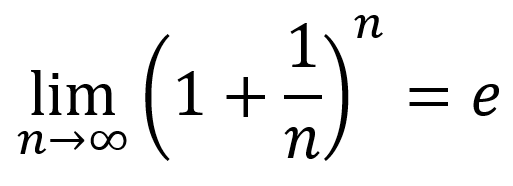I enjoy reading about and studying mathematics. One of my favorite books is A History of π. I’ve used this book to inspire my Pi Day (March 14) programs. It’s fascinating stuff.
What I don’t enjoy about mathematics, of course, is doing the math. This conflict is resolved by programming, where I can attempt to pound out a formula and then let the computer toil with the calculations. The compiler is more forgiving than any math instructor, showing me where I’ve erred and giving me a chance to try again.
For this month’s challenge, the topic is Euler’s number, the mathematical constant e. Once again, it’s fascinating to read about this value and even watch YouTube videos (this one is excellent) on how it works and its history.
Figure 1 illustrates the e equation, which was discovered by Italian mathematician Jacob Bernoulli in 1683. The result was calculated by Euler as the value 2.71828182845904523536028747135266250 or thereabouts. It’s one of those magic numbers like π that’s transcendental and irrational — and lots of fun!

Figure 1. Bernoulli’s equation, which Euler (or Gauss) calculated to the value of e.
In the C language, the e constant is defined in the math.h header file, thus:
#define M_E 2.71828182845904523536028747135266250
Yes, it’s that important.
Your challenge is to write code that calculates the value e. It’s not really that difficult, once you unwind the formula shown in Figure 1 and translate it into C code. But that’s not all! No, you must run and run your the code through a loop in order to obtain the most accurate representation of the value e.
How do you know your calculation is a “most accurate representation”? As your code calculates the value of e, compare your result with the defined constant M_E. The program shouldn’t finish its calculations until both your value and the M_E constant match.
But wait! There’s more . . .
As your code loops, count the iterations. Once the program arrives at the same value as defined constant M_E, output the number of loops it took to make the match. Here’s output from my solution:
The computer calculated 2.718282 after 220825296 loops
TIP: Some platforms require that you link in the math library if you use any C language math functions. The command line switch to do so is -lm (little L, little M).
If you’re using a terminal window to run your solution, use the time command to see how long it takes the computer to arrive at the solution. Here is the output on my iMac Pro running a 3.2GHz 8-Core Intel Xeon W:
The computer calculated 2.718282 after 220825296 loops real 0m6.678s user 0m6.672s sys 0m0.004s
Here is the output on a PC (Intel NUC) running a 3.1GHz Core i7:
The computer calculated 2.718282 after 220825296 loops real 0m9.696s user 0m9.688s sys 0m0.016s
There! I made my PC feel like crap all day! Perhaps you can do the same!
Please try this Exercise on your own before you view my solution.
I have a theory that the best way to teach or learn maths (warning: British English alert) is to program it. That way you have to actually understand a formula or whatever to program a general case.
I wrote an implementation in JavaScript a while ago.
https://www.codedrome.com/estimating-e-in-javascript/
Waste of time really, only had 18 hits. Almost nobody is interested in doing stuff like that in JavaScript.
I agree. Programming maths (and occasionally I use the British term) really opens my eyes to how things work.
Your JavaScript code is admirable, despite 18 hits!
It’s gone up to 20! That’ll be:
1 – you
2 – me reading it on my tablet where it doesn’t get filtered out of the hit count
Have you heard of Ian Stewart? He writes the sort of books on math(s) that you find in the Popular Science section. I have got about 10 of his books. They are a rich source of ideas to code in C for those who don’t go along with the increasingly frivolous use of software. Not sure if they are available outside the UK but if not you could order them from waterstones.com.
Thanks for the author tip. I’ve been look for good maths books. There are some excellent instructors on YouTube, but I really need a book and study guide to help me.
I have just read this again (for some reason I can’t be bothered to do any actual work this afternoon) and you seem to imply that Euler got 35dp when it takes your program over 220m iterations to get 6dp. I think I must have misunderstood something.
An interesting enhancement would be to count the number of iterations to reach each dp of accuracy. Does it go up, down or jump around for each extra digit?
It would also be interesting to graph the values on each iteration with the iteration count on the x axis and calculated value of e on the y axis. Does it start off too high or too low? Does it slowly approach the true value, or jump repeatedly from too high to too low with an ever-increasing accuracy?
Make it so!